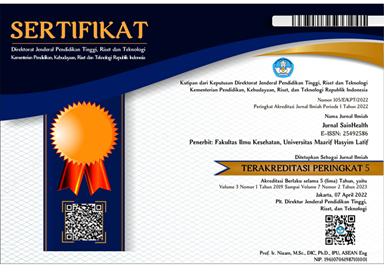DAYA BUNUH EKSTRAK DAUN TOMAT (Solanum lycopersicum L.) TERHADAP LARVA NYAMUK Aedes aegypti
DOI:
https://doi.org/10.51804/jsh.v2i1.176.36-39Keywords:
III instar larvae of Aedes aegypti mosquito, tomato leaves, larvicideAbstract
Dengue hemorrhagic fever (DHF) is a very dangerous disease, caused by Aedes aegypti mosquitoes. One alternative to controlling Aedes aegypti mosquitoes is to use insecticides. But it would be much better if the insecticides used are natural and environmentally friendly, one of them by using Tomato Leaf Extract (Solanum lycopersicum l.). Tomato leaves contain chemical compounds class Alkaloids and Saponins and can serve as anti larvacide. This research is a laboratory experiment which aims to find out the effect of tomato leaf extract (Solanum lycopersicum L.) activity on the death of III instar larvae of Aedes aegypti mosquito. the effectiveness of samples on Aedes aegypti mosquito larvae by treatment of variation of extract concentration 0.2%, 0.4%, 0.6%, 0.8%, 1% with repetition 2 times. In the results of research showed that the smallest concentration that can kill Aedes aegypti mosquito larvae is 0.6% at 16 hours and probit analysis showed that significance is 0,608 greater than intercept 0.003, it shows that the extract of tomato leaves affects the death of III instar larvae of Aedes aegypti mosquito.References
Cania, E., & Setyanimgrum, E. (2013). Uji Efektivitas Larvasida Ekstrak Daun Legundi (Vitex trifolia) terhadap Larva Aedes aegypti. Medical Journal of Lampung University, 52(4), 52–60.
Dwi, S. (2011). Sintesis Dan Uji Antimalaria Senyawa Organologam Besi(Iii), (Iii), 4–7.
Ekawati, E. R., Santoso, S. D., & Purwanti, Y. R. (2017). PEMANFAATAN KULIT BUAH JERUK NIPIS (Citrus aurantifolia) SEBAGAI LARVASIDA Aedes aegypti INSTAR III. Jurnal Biota Edisi Januari, 3(1), 1–5.
Ellyfas, K., Suprobowati, O. D., & SSBU, D. (2012). Pengaruh Pemberian Ekstrak Buah Nanas (Ananas comosus (L.)Merr.) terhadap Kematian Larva Aedes aegypti. Jurnal Analisis Kesehatan.
Farid, A. M. (2015). Effectivity Of Papaya Leaves ( Carica papaya l ) As Inhibitor Of Aedes Aegypti Larvae, 4, 2–5.
Isrianto, P. L., & Kristianto, S. (2017). PERBANDINGAN EKSTRAK ETANOL BUAH LERAK DAN ABATE TERHADAP MORTALITAS LARVA Aedes aegypti Instar III 1,2), (September), 492–500.
Kendran, A.A.S., , Gelgel, Pertiwi, Anthara, Dharmayuda, Anggreni, L.D. (2013). Toksisitas Ekstrak Daun Sirih Merah pada Tikus Putih Penderita Diabetes Melitus, Jurnal Veteriner, 14(4), 527–533.
Listiyati, A. K., Nurkalis, U., & Hestiningsih, R. (2012). Ekstraksi Nikotin Dari Daun Tembakau ( Nicotina Tabacum ) dan Pemanfaatannya sebagai Insektisida Nabati Pembunuh Nyamuk Aedes sp. Jurnal Ilmiah Mahasiswa, 2(2), 67–70.
Nopianti, S., & Astuti, D. (2000). Efektivitas Buah Belimbing Wuluh (Averrhoa bilimbi L .) untuk Membunuh Larva Nyamuk Anopheles aconitus Instar III. Jurnal Kesehatan, 1(2), 103–114.
Nugroho, A. D. (2011). Kematian Larva Aedes aegypti Setelah Pemberian Abate Di bandingkan Dengan Pemberian Serbuk Serai. Jurnal Kesehatan Masyarakat, 7(1), 91–96. https://doi.org/ISSN 1858-1196
Palgunadi, B. U., & Rahayu, A. (2011). Dengue Aedes aegypti As Dengue Haemorrhagic Fever Vector. Lecturer Faculty of Medicine.
Santoso, S. D., & Suryanto, I. (2017). KOMPARASI EFEK PEMBERIAN MINYAK JINTAN HITAM (Nigella sativa) DENGAN MINYAK ZAITUN (Olea europea) TERHADAP PENURUNAN GLUKOSA DARAH PADA MENCIT (Mus musculus) STRAIN Balb/c. SainHealth, 1(1),s 36–42.
Downloads
Published
Issue
Section
License
Jurnal SainHealth is licensed under Creative Commons Attribution 4.0 International License.
Under the following terms:
Attribution — You must give appropriate credit, provide a link to the license, and indicate if changes were made. You may do so in any reasonable manner, but not in any way that suggests the licensor endorses you or your use.
No additional restrictions — You may not apply legal terms or technological measures that legally restrict others from doing anything the license permits.
















